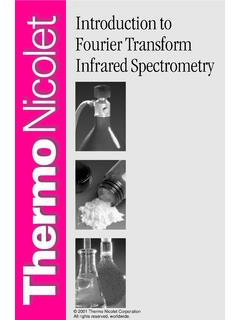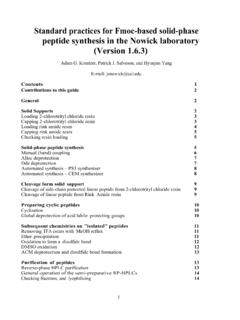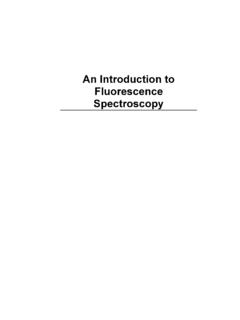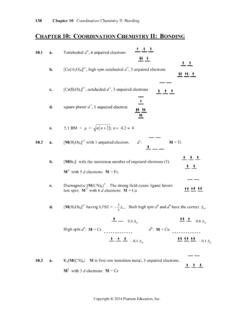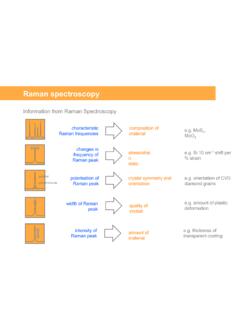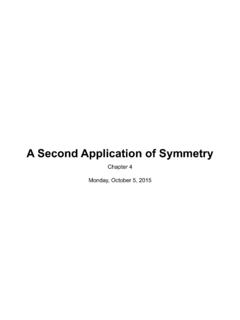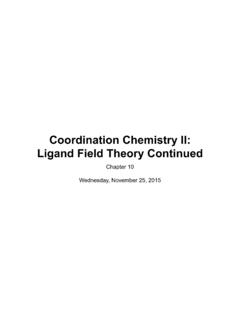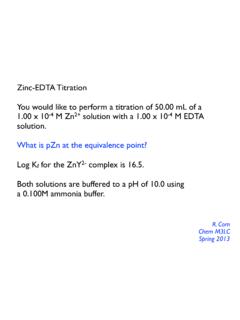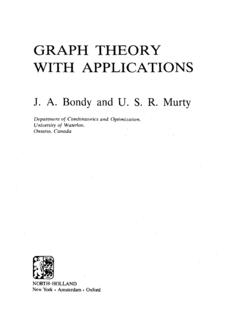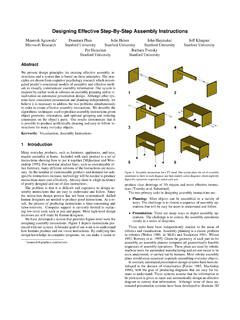Transcription of Coordination Chemistry III: Tanabe-Sugano Diagrams and ...
1 Coordination Chemistry III: Tanabe-Sugano Diagrams and Charge TransferChapter 11extra material (to finish Chapter 11)Symmetry Labels for ConfigurationsFree ion terms split into states in the ligand field, according to symmetry:The state labels also indicate the degeneracy of the electron configuration:d7 Tanabe-Sugano DiagramE/ B o/ B4F2G2Eg2T1g2A1g2T2g4P4A2g4T1g(4P)4T2g4T 1g(4F)Complexes with d4-d7electron counts are special at small values of o/Bthe diagram looks similar to the d2diagram at larger values of o/B, there is a break in the diagram leading to a new ground state electron configurationd7 Tanabe-Sugano DiagramE/ B o/ B4F2G2Eg2T1g2A1g2T2g4P4A2g4T1g(4P)4T2g4T 1g(4F)small oHigh Spinlarge oLow SpinComplexes with d4-d7electron counts are special at small values of o/Bthe diagram looks similar to the d2diagram at larger values of o/B, there is a break in the diagram leading to a new ground state electron configurationSample Problem, [Co(NH3)6]2+[Co(NH3)6]2+ has o= 10,100 cm 1and B= 920 cm 1.
2 How many electronic absorptions do you expect for the complex and at what energies?To solve this problem we first need to determine the d-electron count for the [Co(NH3)6]2+ 6 2 6NH3 Co 2 So we have cobalt(II). Since cobalt is in the ninth column of the Periodic Table, it must be a d7complex so we can use the d7 Tanabe-Sugano diagram from the last we need to find o/B: OB 10,100 cm 1920 cm 1 11 Sample Problem, [Co(NH3)6]2+E/ B o/ B4F2G2Eg2T1g2A1g2T2g4P4A2g4T1g(4P)4T2g4T 1g(4F)small oHigh Spinlarge oLow SpinWe have d7[Co(NH3)6]2+with o/B 11So we expect three absorptions in the UV-vis Problem, [Co(NH3)6]2+E/ B o/ B4F2G2Eg2T1g2A1g2T2g4P4A2g4T1g(4P)4T2g4T 1g(4F)small oHigh Spinlarge oLow SpinWe have d7[Co(NH3)6]2+with o/B 11So we expect three absorptions in the UV-vis 10E1 10B 10 920 cm 1 9200 cm 1 Sample Problem, [Co(NH3)6]2+E/ B o/ B4F2G2Eg2T1g2A1g2T2g4P4A2g4T1g(4P)4T2g4T 1g(4F)small oHigh Spinlarge oLow SpinWe have d7[Co(NH3)6]2+with o/B 11So we expect three absorptions in the UV-vis 18E1 18B 18 920 cm 1 16,500 cm 1 Sample Problem, [Co(NH3)6]2+E/ B o/ B4F2G2Eg2T1g2A1g2T2g4P4A2g4T1g(4P)4T2g4T 1g(4F)small oHigh Spinlarge oLow SpinWe have d7[Co(NH3)6]2+with o/B 11So we expect three absorptions in the UV-vis 23E3 23B 23 920 cm 1 21,200 cm 1 Simplified Tanabe-Sugano Diagramsd1d9 Spectra of First-Row HS [M(H2O)]
3 6]n+Complexes Jahn-Teller Effect in SpectroscopyCuII, d9t2gegFrontier MO diagramThere should only be one d dtransition, why is there a split in the absorption band at 900 nm? Jahn-Teller Theorem: complexes with unequal occupation of degenerate orbitals will distort to lower their energy degenerate electronic states occur when a degenerate orbital set (t2gor eg) is partially filled with electrons (not half-filled) partially occupied egorbitals (M L *) lead to more pronounced distortions than partially-occupied t2gorbitals (non-bonding) the most common distortion is tetragonal, but trigonal distortions are also possiblet2gegOhMO diagramb2g{dxy}a1g{dz2}D4hMO diagrameg{dxz, dyz}b1g{dx2 y2}Jahn-Teller Effect in SpectroscopyTetrahedral ComplexesNo inversion center Laporte selection rule does not apply more intense absorptions than in octahedral complexesAs a result, we can use octahedral d10-nT-S Diagrams to describe dntetrahedral complexes. For example, d8looks like d2octahedral, d7looks like d3, Formalism: since the splitting of the d-orbitals is opposite in tetrahedral and octahedral complexes, tetrahedral configurations with nempty orbitals (n holes ) have the same symmetry as dnoctahedral configurations: Charge Transfer TransitionsIn addition to transitions between d-orbitals, transitions between ligand-based orbitals and metal d-orbitals are transfer transitions since an electron is transferred from the metal to the ligand or vice versa-very intense transitions since they are Laporte and spin allowed ( ~50,000 compared to <20 L mol-1cm-1for d-dtransitions)-energies often depends strongly on solvent (solvatochromic) since the charge transfer changes the dipole moment of the complex this can be used to distinguish between charge transfer bands and d-dtransitionspermanganate is intenselypurple due to CT from O 2pto Mn7+d-orbitalCharge Transfer Transitions2.
4 Ligand to metal CT (LMCT)1. metal to ligand CT (MLCT)3. intraligand CT: involves electron transfer within a ligand or betweenligands; any energy. higher energy ligand oxidized metal reduced higher energy ligand reduced metal oxidizedApplication of CT: Dye-Sensitized Solar CellsA dye-sensitized solar cell uses an MLCT dye adsorbed on a high surface area TiO2nanoparticle film to absorb sunlight and produce electricity. Application of CT: Dye-Sensitized Solar CellsApplication of CT: Dye-Sensitized Solar Cells486 Brian E. Hardin, of CT: Dye-Sensitized Solar CellsApplication of CT: Dye-Sensitized Solar CellsHOMO localized on electrolyte side, far from localized on anchoring ligands, next to TiO2surface. rapid electron transfer into TiO2 TiO2surface TiO2surface FinGood luck on the final, have a great break,and see you around campus!
